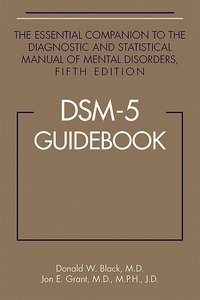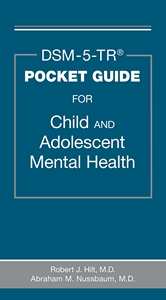DSM-5® Guidebook
The Essential Companion to the Diagnostic and Statistical Manual of Mental Disorders, Fifth Edition
View Pricing
Description
DSM-5 Guidebook: The Essential Companion to the Diagnostic and Statistical Manual of Mental Disorders, Fifth Edition is a user-friendly, supplementary guide for psychiatrists, psychologists, and other mental health practitioners who need to know how DSM-5 differs from its predecessor in terms of organizational structure, diagnostic categories, and the criteria themselves. While it does not replace the comprehensive and authoritative DSM-5, it illuminates its content by teaching mental health professionals how to use the revised diagnostic criteria and by providing a practical context for its clinical use.
The book offers many valuable features, including:
- An historical overview of the development of the DSM in general, and DSM-5 in particular, a progression that might be said to mirror the evolution of psychiatry as a whole. The material on the creation of DSM-5 includes coverage of dimensional assessment, reliability and field trials, and the controversies that arose during development of DSM-5.
- An indispensable chapter on how to use DSM-5 that addresses coding, diagnostic certainty, the demise of the multiaxial system, and the key changes to each diagnostic category.
- Full coverage of the significant reorganization from DSM-IV-TR to DSM-5, which is designed to incorporate advances in neuroscience, brain imaging and genetics. Chapters were reordered to reflect scientific advances in the understanding of psychiatric disorders, and the presumed etiological and the pathophysiological relationships among them.
- Extensive coverage of the decision to integrate dimensional measures into DSM-5, which may enhance the clinician's ability to assess symptom variation and severity and aid in patient evaluation, treatment decisions, and outcome monitoring. The various measures are presented and their use discussed.
- Finally, as the authors were not part of the revision process, they offer a fresh, down-to-earth perspective that will resonate with clinicians by focusing on the changes that will most significantly impact clinicians' professional lives.
DSM-5 Guidebook provides a roadmap to the many changes in this living document, DSM-5, and will prove invaluable to psychiatrists, psychologists, psychiatric nurses, neurologists, social workers, and all who strive to understand mental illness as it is conceived today.
Contents
- About the Authors
- Preface
- Acknowledgments
- Introduction
- Chapter 1. The march to DSM-5
- Chapter 2. Use of DSM-5 and major changes from DSM-IV-TR
- Chapter 3. Neurodevelopmental disorders
- Chapter 4. Schizophrenia spectrum and other psychotic disorders
- Chapter 5. Mood disorders
- Chapter 6. Anxiety disorders
- Chapter 7. Obsessive-compulsive and related disorders
- Chapter 8. Trauma- and stressor-related disorders
- Chapter 9. Dissociative disorders
- Chapter 10. Somatic symptom and related disorders
- Chapter 11. Feeding and eating disorders
- Chapter 12. Elimination disorders
- Chapter 13. Sleep-wake disorders
- Chapter 14. Sexual dysfunctions, gender dysphoria, and paraphilic disorders
- Chapter 15. Disruptive, impulse-control, and conduct disorders
- Chapter 16. Substance-related and addictive disorders
- Chapter 17. Neurocognitive disorders
- Chapter 18. Personality disorders
- Chapter 19. Medication-Induced movement disorders and other conditions that may be a focus of clinical attention
- Chapter 20. Assessment measures
- Chapter 21. Alternative DSM-5 model for personality disorders
- Chapter 22. Conditions for further study
- References
- Appendix: DSM-5 Classification
- Index
About the Authors
Donald W. Black, M.D., is Vice Chair for Education, Department of Psychiatry, and Professor of Psychiatry at the University of Iowa Carver College of Medicine in Iowa City, Iowa.
Jon E. Grant, M.D., M.P.H., J.D., is Professor in the Department of Psychiatry and Behavioral Neuroscience at the University of Chicago Pritzker School of Medicine in Chicago, Illinois.
Related Products
Carousel Control - items will scroll by tabbing through them, otherwise arrows can be used to scroll one item at a time








